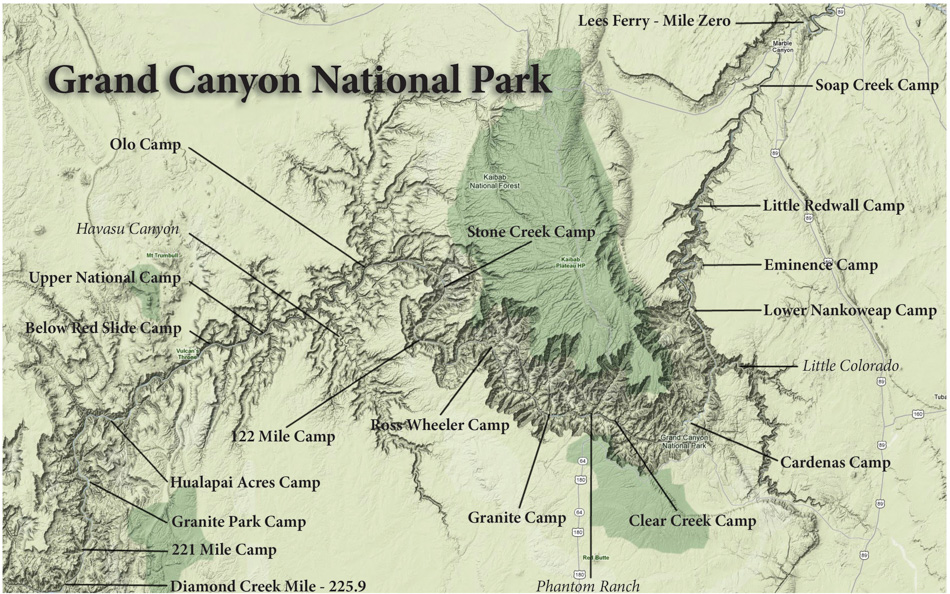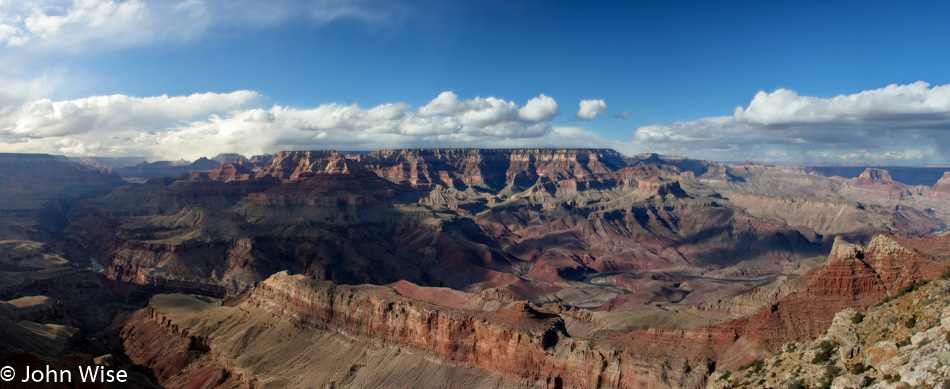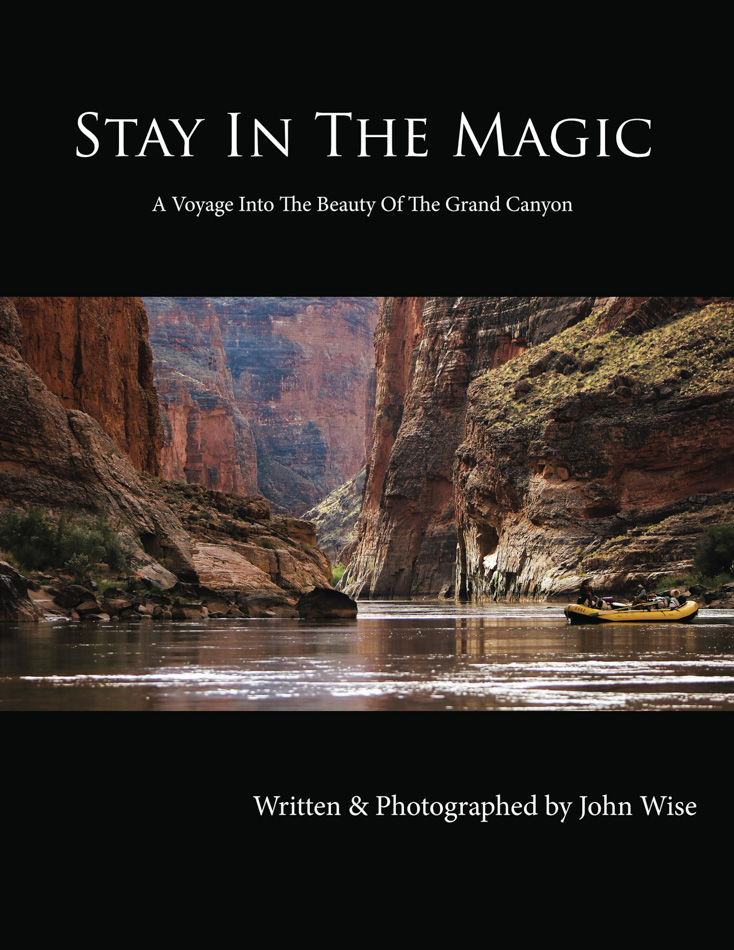
Here we are, standing on the beach. The shore is buzzing with activity as seven river guides and two helpers finish preparing four dories and three supply rafts for our imminent departure. A few hours earlier, 13 adventurous men and women were climbing out of warm, cozy beds at a hotel in Flagstaff, Arizona. After breakfast, my wife Caroline and I walked outside to find our fellow passengers, two vans, and two of the guides who were there to ensure we were packed and ready to go. With our waterproof bags loaded into the vans, we piled our sense of excitement on board and took a seat, ready to be delivered to the Colorado River for a launch into the experience of a lifetime.
Lees Ferry, where the Colorado enters the Grand Canyon, is the point designated by the National Park Service as the northern boundary of America’s 15th National Park. We are at mile zero, the put-in location for all craft that depart this shore to shuttle the entrant souls through the approaching funnel of time and history. Can one be prepared for this? Absolutely, for if you find yourself here with a figurative boarding pass in hand, you have already made the biggest decision in getting ready to discover the unknown. We will not leave the way we came in. Fate will play its hand.
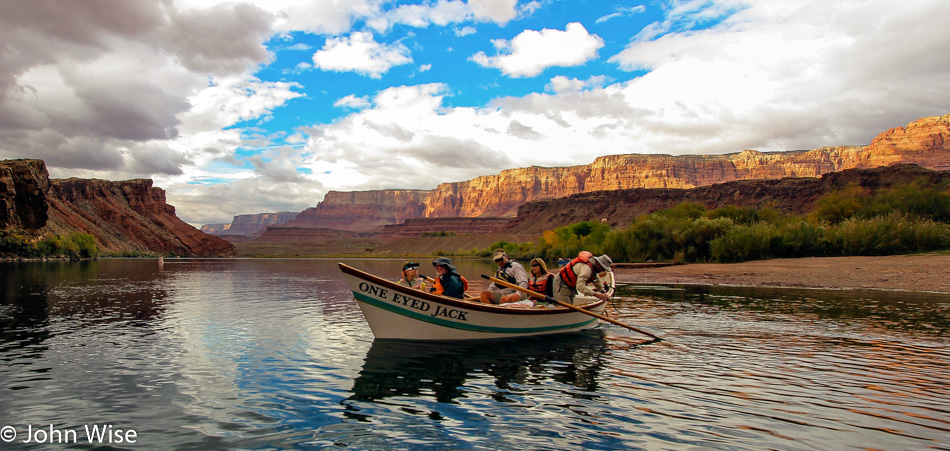
I am about to be enrapt by this Grandest of Canyons. Naïveté will attempt to stand guard against the emotional onslaught the river is going to deliver, but it too will be washed away by the force of nature residing here. The naive me of moments ago will disappear as an unimaginable future me emerges 225.9 miles downstream.
Trip leader Rondo Buecheler grabs our attention with the commands, “Do as we say, don’t panic, tighten those straps, get on board, and put your stuff in the hatch.” I clamber aboard the dory named Sam McGee, Jeffe Aronson’s rig, heading up front where I was directed, while Caroline sits in the back. I make a quick inventory of Jeffe’s dory and get to packing my gear into the cramped hatch in the bow. A pump and a hose are on my left; easy enough to figure this is for draining either the footwell or one of the three watertight compartments that are supposed to keep our dory afloat when the rest of the boat is full of water. Thick woven straps are firmly attached to the forward compartment, forming handles. We are to grasp one of these and the gunwale to form a triangulated grip that will stop us from being thrown from side to side, hopefully keeping us in the boat, too. Between the straps is a level, which at first glance appears to be a decoration but instead proves to be quite useful. This small feature allows the boatmen to quickly determine if we are in trim, as a balanced dory is easier to control in whitewater.
It’s 10:30 in the morning, and we are going down this river starting right about now. Hey, wait a minute, I hardly know what is going on! We’ve chased around, listened to safety briefings, donned life jackets, and now magically, I’m prepared to embark on this monumental trip, just like that? But these words are only beginning to form in my mind, long before they are able to find utterance from my gaping mouth, as we approach our first riffle at the confluence of the Colorado and the Paria Rivers. IT’S HUGE. Are we gonna get wet? This water is 46 chilly degrees, right? Hypothermia, get ready to embrace me. I triangulate my white-knuckle grip on the gunwale and that measly strap flimsily attached to the matchstick boat I foolishly paid all that money to ride on, and now I’m facing my own untimely demise as a raging riffle is about to have its way on my pitiful being. We are not riding the rails of the Jungle Cruise in Disneyland; this can’t be the first time the reality of the situation we bargained for is dawning on me, or can it?

Ah, a riffle, kind of like a ripple. Okay, I get it; I thought that looked a lot bigger from back there. I’m cool, phew. I release my grip, allowing color to return to my knuckles, and blood flows back into my lips, pressed together tightly, concealing clenched teeth.
The tension remains high; my senses are fully alert. Moving away from the open expanse of Lees Ferry, we are surrounded by the encroaching walls that will hug the river for the majority of the 18 days we’ll be in the Canyon. I am overwhelmed by the idea that after almost a year of waiting and anticipation, Caroline and I are now on the Colorado, in the Grand Canyon, floating downstream on a dory. Hit by an explosion of details, we are dwarfed under the rising cliffs that are stretching to the sky.
To the right and left, the river flows past rock millions of years old. I look up to the sky and then deep into the Canyon before me. I listen to the water running underneath us and to Jeffe, who has started pointing to sights deserving of my attention. I try to hold on to the many sounds disappearing behind me that are being replaced by the music of a river carving a symphony through the landscape ahead.
Each moment is a new sensation, jolting me to focus on what has just appeared before us. I look for fish below and birds above. With deep breaths, I try to smell the few scents that might be found on a cold river running through a vast desert, but little is familiar. Jagged rocks and broken cliffs offer up an indecipherable geometry that is adding complexity to my ability to try and understand the forms of unfolding geologic architecture designed by the hand of nature. How do time and weather create what amounts to visual noise that a human mind looking for order is able to find so enchantingly delightful?
No, really, we’re just 30 minutes downstream? Wow, that leaves a lot more to see; not sure I’m ready for so much looking and seeing. Are you boatmen sure it’s safe to expose the mind to so much intensity all in one hour, one day? Jeffe assures me I am fine. No kidding, more beauty, more adventure, more everything lies ahead? I should brace myself.

The Colorado flows at little more than a leisurely three miles per hour on calm stretches – a snail’s pace. As slow as this is, we are soon passing under the Navajo Bridge. To date, Caroline and I had only driven over this crossing and, on rare occasions, stood on it while watching rafting trips pass below. Today, we are that trip floating by. We have traveled barely five miles since putting in, and I am at once troubled that we have already gone so far, leaving only 220 miles to go, and then again ecstatic that we still have 220 miles to go. How do I slow this rocket sled to allow careful examination and mental inventorying of every square inch I gaze upon?
The unspeakable beauty and infinite detail one sees in the first six miles alone is worthy of a book of poetic observations that should be capable of transporting our spirit to the lofty heights only nature is able to attain. Instead, I offer up a faint murmur of “wow” as I shrink under the Canyon’s epistle of light and gravity spilling into every atom of my being.
Jeffe puts just enough work into the oars to present the world of the Grand Canyon in slow motion – which may still be a little too fast. Good thing the sky is overcast – it offers me a great excuse for not snapping off hundreds of photos per hour. If I wasn’t afraid that this was most likely going to be my one and only trip down the Colorado, I might consider putting the camera away for the duration to allow myself to fall into the lazy mode of the observer. Instead, I feel the need for a record to spark what might someday be a failing memory of how, indeed, Caroline and I had once participated in traveling the muddy red waters of one of America’s greatest rivers.

We are approaching midday. As if reading my thoughts, the boatmen land their vessels onshore and, with programmed precision, jump into action, making lunch. A blue tarp is stretched out on the sand to capture food scraps, keeping the beach clean for those who will follow us. Waterproof food buckets are extracted from hatches, and a table emerges from some hidden corner to be propped up in seconds. Water buckets and a foot pump are quickly put to use for hand washing before a flurry of cutting, opening, slicing, and presenting all the fixings for us passengers and crew to make sandwiches. A potted plant of mums is brought to the table to complete the presentation.
Our waterside picnic must be a first-day treat, as we are offered deli meats, a variety of cheeses, lettuce, tomato slices, red onion, and the luxury of fresh avocado. Apple and orange slices are arranged on a separate table with maybe three different choices of cookies, peanut butter and jelly for those who prefer a PBJ for lunch, and potato chips. With stomachs full, it’s time for the third safety briefing of the day – river and rapid awareness. In a few minutes, we’ll be running Badger Rapid, our first journey into whitewater. Don’t panic if you find yourself in the water; your life jacket will buoy you to the surface in less than two seconds. DON’T PANIC!
Listen to the instructions of your boatman. If he yells, “Right!” you high-side to the right. “Left!” means throw your weight left. This lesson in high-siding is one of the more important reflexes we must adopt and make instinctual. With rigid boats, the weight distribution of the passengers plays a significant role in preventing a dory from flipping over and dumping passengers and boatmen into the turmoil of a rapid. Once again, DON’T PANIC!
Our river guides and their helpers move with purpose to stow things used to make lunch. The mums are hidden away again in one of the sealed compartments of Rondo’s dory. Other than the conversation between boatmen to coordinate what happens next, we passengers are mostly quiet besides the nervous excitement reflected in the expressions we wear. In the final couple of minutes onshore, we adjust our waterproof clothes, tighten drawstrings, and zip jackets up high – maybe believing we can stop the cold water from finding warm skin. Caroline grasps my hand; I squeeze back as we smile at one another with a questioning look that asks, “Are you ready for this?” The boatmen, on the other hand, are calm and casual.
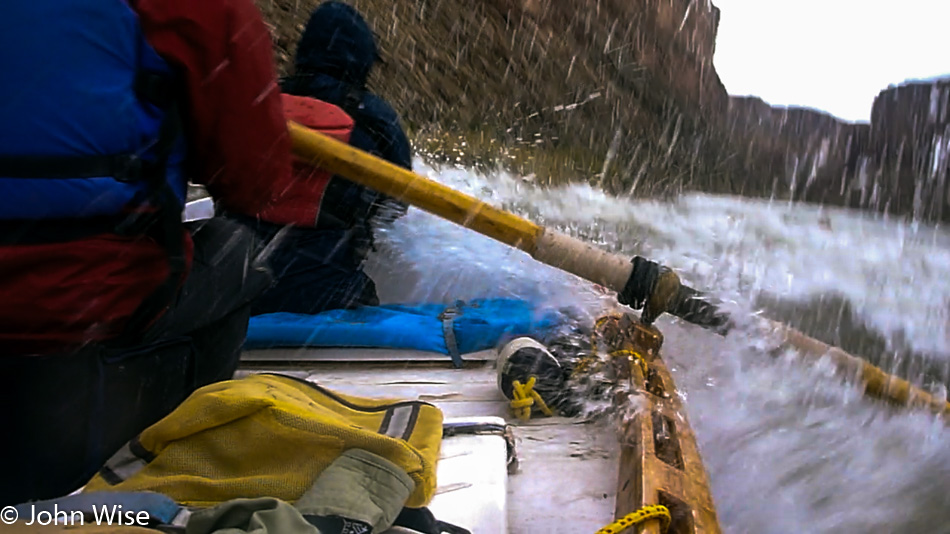
Badger Creek Rapid is in sight; it has been since we pulled ashore for lunch. Watching and listening to its roar surely adds to the tension and the excitement I am feeling. Measuring this rapid’s rage is impossible from my perspective on this narrow beach. What Badger is capable of delivering will be known shortly, as the command to get on board has now been given. We are in our seats and holding on. The boatmen nudge the dories back into the flow, and we are off. In mere moments, the accelerating water pulls us into the rapid, where a well-placed oar and quick turn bring us to our first frothy wet kiss from the river. As the bow begins to dip, coursing down with the flow of water before riding up a wave, thoughts of even larger rapids ahead are the furthest thing from my mind. This must be the biggest whitewater ever.
Fear sits with me, but before I’m able to transition to panic, we are entering a rapid that looks as stormy as the sky overhead. The calm, dark green water from Lees Ferry is now a brown, murky, and merciless river. My mind is a racing jumble of doubt, asking, do I have any idea what comes next and what is my role here? The dory lurches into a roll to the left and quickly jolts to the right. My mind forces my eyes to get a lock on the situation, but nothing stays the same long enough for me to grasp what action is required. Less than 45 seconds later we have passed through our first encounter with whitewater unscathed and mostly dry.
The route we travel follows the oar strokes of the first men to row this stretch of the Colorado, the Powell Expedition of 1869. Back then, this was a great unknown; it was unmapped and fraught with danger. Led by one-armed Civil War veteran John Wesley Powell and worked hard by the labor of eight other courageous men, the group toiled under incredibly harsh conditions. A footnote in history was to be the reward for these men who were the first to travel the great river through what is now Grand Canyon National Park. Today, the Canyon and the Colorado are still full of danger, but the environment, as perceived in the minds of people, has changed from a barren wasteland to a fragile ecosystem containing immeasurable beauty enjoyed by visitors from around the world.

The remaining few miles that we’re on the river today are spent barely rowing at all. We float downstream, the current gently delivering us to an end we know not. A rain, so fine as to easily be confused with a mist, sprinkles ever so delicately on the now-calm Colorado. We drift along. These lazy moments set the mental pace that assures me that it is okay to relax, slow down, and allow what lies ahead to unfold and present itself in its own time. Our influence on the world around us is being eroded. Our anchor to what we think we know will have to be recast, as our sense of place is deconstructed and rebuilt even as we sit here, unaware that this process is at work on all that is within this Canyon, including us.

The afternoon welcomes my presence while the Canyon ignores it, but I cannot ignore the Canyon. My physical location is easily known, but where else might I be going? Some hours ago, I was filled with anticipation that we were about to begin this journey, but now Lees Ferry is nearly forgotten – full immersion is busy at work. I try my best to find comprehension that not only did I finally arrive today, but that this will be where I will remain for the next weeks. Here, under these massive slabs of earth, I am offered the chance to indulge my curiosity for the mystery of what lies ahead.

It’s only 4:00 pm as we pull ashore at Soap Creek Camp. Eleven miles is what we have traversed, but it has already been a thousand miles of experience for my memories. Out of the dories, on terra firma, the trance is broken; we passengers scatter to identify the piece of real estate that will be our first home down below the rim. Satisfied that Caroline and I have made the perfect choice, and no better site exists to pitch our tent, we mark the spot as claimed with a dropped bag of gear and join the others who are gathering at the beach for another lesson in how to live in the Canyon.
How does one use the toilet in this place without toilets? Take notice: you are about to be potty trained for river life. At lunch, the lesson regarding number one, pee-pee, urination, or whatever you want to call it, was given; it is done in the river by all of us, men and women alike. There are no trees in the river to hide behind, and don’t cheat and pee on the sand; it will turn green and stink – get it in the water. Men, aim like you mean it; women, try not to get stuck in the mud. This late afternoon lesson deals with number two, the BM, aka defecation. Jeffe is the teacher for those of us uninitiated in the use of “the Unit,” also known as La Pooperia, the Groover, and the toilet if you’d like. First of all, everything that enters the Canyon must leave the Canyon – meaning everything! Next, on the ground beside our boatman, is a World War II-style ammunition can with a cozy toilet seat fixed atop. Jeffe drops his shorts, revealing his wetsuit bottoms, and takes a seat. He shows us a plastic box containing a roll of toilet paper, the key to “the facilities.” Do not hover over the Unit! Boatmen do not want to clean up the ensuing mess because your dainty butt is afraid to make contact with the seat that 21 of us other poopers have perched upon. Do not use the Unit for urination; it adds extra weight and unnecessary volume; there is a plastic bucket next to it that we empty into the river – use that. If the “key” is not sitting at the hand wash station, which is a good distance away, the Unit is occupied. When finished with your business, sprinkle with Clorox Crystals from the bottle conveniently placed next to the can, close the lid, cover with the netting that helps keep pests away, bring back the box of TP to the next in line – and WASH YOUR HANDS!
Once this most important of all lessons has been completed, we’re off to the next subject. Some of you may have never pitched a tent, here is how these work. Get it? Got it? Good. Now, go set up your camp, we leave on a hike up Soap Creek Canyon shortly. School’s out for the day, but the adventure is not. Apparently, my brain has reached a first-day saturation point, causing me to move into befuddlement because Caroline and I hit the trail without our GPS, extra lenses, tripod, a backpack, or waterproof bag for the camera, should it rain. We brought the camera, a water bottle, and nothing else.

Glistening mud, pools of red water, slick rock, and wet sand. The muck on our invisible trail quickly tugs at a foot, holding fast, trying to keep the shoe it has captured. The majority of the group is ahead of Caroline and me, racing off somewhere, while our curiosity has us taking a close examination of cracked earth, lichen, and the patterns left on still muddy surfaces by the water that must have been flowing here just a day or two ago. Details in the rocks, eroding fissures in boulders, and the contours of the drainage all present new information to our eyes. They hungrily consume every last morsel of beauty that, even under a gray overcast sky, is a delight to behold.

Before we catch up to the others in our group, they have already turned around and are speeding right back at us. In a blur, they are again out of sight. No one presses us to quicken our pace, and so we meander, lingering to gawk in disbelief that we should be finding ourselves here in the Grand Canyon, taking a hike from off the Colorado River. Two of our boatmen, Steve Kenney and Jeffe bring up the rear, seemingly content to chat with each other and give us our space to be here in our moment.

Almost near camp again, a hole opens in the cloud cover, letting the sun pour its late afternoon glow upon a narrow strip of ridgeline far above us. This is in keeping with Caroline’s and my experience that when we are happily traveling together and are accepting what life is delivering, nearly without fail, we will be daily witnesses to at least a fleeting glimpse of blue sky or sun dancing upon a surface, eliciting our oohs and aahs. And so it was as we finished our first hour-and-a-half-long hike from the river into a side canyon.
Dinner is eaten around a blazing campfire. In the kitchen, dory boatman Bruce Keller and Katrina Cornell, who is rowing one of the supply rafts, work the camp stove to prepare tonight’s menu of salmon, asparagus, and a mixed salad. But as good as dinner is, it is a dessert that steals the show – fresh sliced strawberries with shortcake and whipped cream.
The embers of the campfire glow red hot, wisps of golden flame flicker above what remains of the disappearing wood. In quiet disbelief that this was merely the first day, we collectively sat in stunned silence, mesmerized by our experiences and the firelight at the center of our camp circle. Maybe knowing we are incapable of even basic human speech, Jeffe brings over his guitar and, with a wonderful singing voice, begins to heap the icing upon our peach of a day. After half a dozen classic folk songs and a couple of old rock anthems, someone speaks up, remarking that it is already 8:00 pm. Like an alarm working in reverse, this is apparently the cue for the majority of passengers and a few of the crew to peel out of the low-slung canvas chairs and make their way to a tent out in the darkness for a night of sleep. They scamper off, leaving but a small handful of us to wait until the fire exhausts itself.

Lucky us, the entertainment continues. On this first night, we are the only two passengers who remain at the camp circle. Caroline and I hover like moths attracted to the light of the fire, not wanting to miss a minute that might prove valuable to filling our wallets with experience. Still sitting next to the fire, Bruce begins reminiscing about previous exotic river journeys from the Tatshenshini-Alsek in Alaska to the Zambezi in Africa before embarking on this humorous story set in another far away land.
We were in Papua New Guinea, where a difficult, windy, wet day had been tormenting the passengers. On the river, us boatmen rowed into a strong headwind where a tropical storm kept everyone in rain gear. The rain wouldn’t relent. By the time the group pulled off the river, the crew got to work setting up the kitchen and wanted to start a fire so our guests could start drying off and find some warmth. The fire pan is on the ground, wood is stacked in a pile, and kindling sits ready as one of the other boatmen attempts to get the fire burning. With the high humidity, rain, and driving wind, it was proving impossible to light the damp kindling. Try as we might, we could not get the spark to catch hold. Off to the side, a couple of the nearly-naked New Guinea men who were along as the local experts, watched in amusement. We continued to toil in frustration. Finally, the tribesmen approached and offered their assistance. One of the men reached into the only thing he was wearing, his penis gourd. From deep within his gourd, he pulled dry kindling and a match and, in a second had enough fire started to get things roaring along.
No one saw that coming, not the folks on the trip that day and not one of us around our campfire. Howls of laughter for the best story of the night erupted.
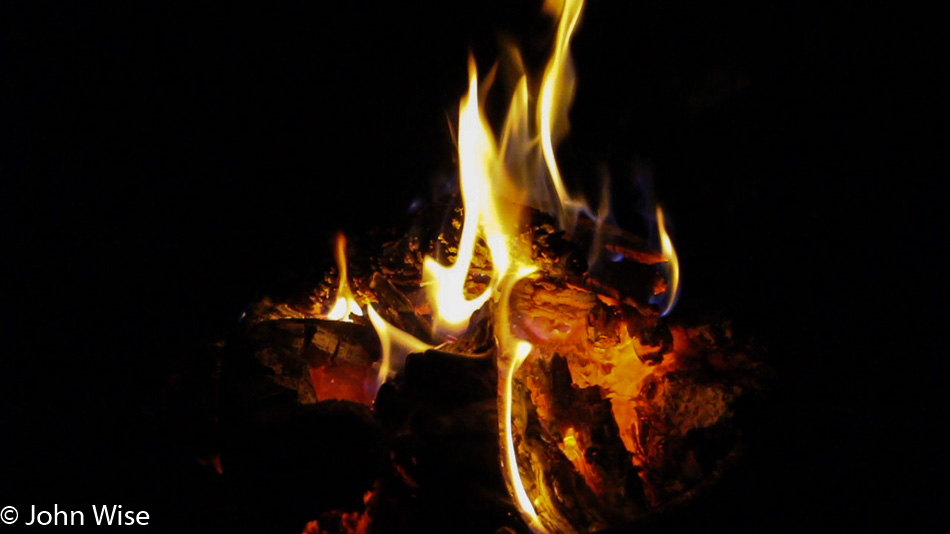
A few minutes later, the remaining boatmen abandon the fire with wishes to rest well before returning to their boats where they will stay for the night. Now facing the dark solitude of the chilling night air alone, we decide to retire as well. Off to our tent, we go. Even with a three-person tent, we are crowded. Waterproof bags and our backpacks compete for space, as we hadn’t realized in our exhaustion that they should have been left outside the tent.
Sleep this evening is fitful. Too hot, too cold. The noise of Soap Creek Rapid is crashing behind our heads, along with the Canyon sounds still unfamiliar to our resting ears. This canyon orchestra works to toss us about and keep us from fully embracing sleep. Mr. Sandman apparently does visit us, but instead of carrying us off to the land of deep slumber, he simply sprinkles the tent and sleeping bags with a bit of sand and is quickly away.
–From my book titled: Stay In The Magic – A Voyage Into The Beauty Of The Grand Canyon about our journey down the Colorado back in late 2010.

